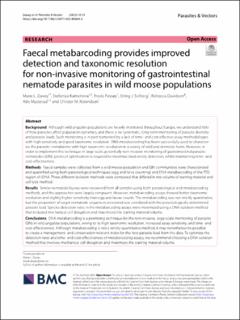| dc.contributor.author | Davey, Marie Louise | |
| dc.contributor.author | Kamenova, Stefaniya | |
| dc.contributor.author | Fossøy, Frode | |
| dc.contributor.author | Solberg, Erling Johan | |
| dc.contributor.author | Davidson, Rebecca K. | |
| dc.contributor.author | Mysterud, Atle | |
| dc.contributor.author | Rolandsen, Christer Moe | |
| dc.date.accessioned | 2023-03-27T09:25:03Z | |
| dc.date.available | 2023-03-27T09:25:03Z | |
| dc.date.created | 2023-01-19T12:29:49Z | |
| dc.date.issued | 2023 | |
| dc.identifier.issn | 1756-3305 | |
| dc.identifier.uri | https://hdl.handle.net/11250/3060530 | |
| dc.description.abstract | Background Although wild ungulate populations are heavily monitored throughout Europe, we understand little of how parasites afect population dynamics, and there is no systematic, long-term monitoring of parasite diversity and parasite loads. Such monitoring is in part hampered by a lack of time- and cost-efective assay methodologies with high sensitivity and good taxonomic resolution. DNA metabarcoding has been successfully used to characterize the parasitic nemabiome with high taxonomic resolution in a variety of wild and domestic hosts. However, in order to implement this technique in large-scale, potentially non-invasive monitoring of gastrointestinal parasitic nematodes (GIN), protocol optimization is required to maximize biodiversity detection, whilst maintaining time- and cost-efectiveness. Methods Faecal samples were collected from a wild moose population and GIN communities were characterized and quantifed using both parasitological techniques (egg and larva counting) and DNA metabarcoding of the ITS2 region of rDNA. Three diferent isolation methods were compared that difered in the volume of starting material and cell lysis method. Results Similar nematode faunas were recovered from all samples using both parasitological and metabarcoding methods, and the approaches were largely congruent. However, metabarcoding assays showed better taxonomic resolution and slightly higher sensitivity than egg and larvae counts. The metabarcoding was not strictly quantitative, but the proportion of target nematode sequences recovered was correlated with the parasitologically determined parasite load. Species detection rates in the metabarcoding assays were maximized using a DNA isolation method that included mechanical cell disruption and maximized the starting material volume. Conclusions DNA metabarcoding is a promising technique for the non-invasive, large-scale monitoring of parasitic GINs in wild ungulate populations, owing to its high taxonomic resolution, increased assay sensitivity, and time- and cost-efectiveness. Although metabarcoding is not a strictly quantitative method, it may nonetheless be possible to create a management- and conservation-relevant index for the host parasite load from this data. To optimize the detection rates and time- and cost-efectiveness of metabarcoding assays, we recommend choosing a DNA isolation method that involves mechanical cell disruption and maximizes the starting material volume Nemabiome, Metabarcoding, ITS2, DNA extraction method, NC1–NC2 primers, Alces alces, Helminth, Ungulates | |
| dc.language.iso | eng | |
| dc.title | Faecal metabarcoding provides improved detection and taxonomic resolution for non-invasive monitoring of gastrointestinal nematode parasites in wild moose populations | |
| dc.title.alternative | Faecal metabarcoding provides improved detection and taxonomic resolution for non-invasive monitoring of gastrointestinal nematode parasites in wild moose populations | |
| dc.type | Peer reviewed | |
| dc.type | Journal article | |
| dc.description.version | publishedVersion | |
| dc.subject.nsi | VDP::Zoologiske og botaniske fag: 480 | |
| dc.subject.nsi | VDP::Zoology and botany: 480 | |
| dc.subject.nsi | VDP::Zoologiske og botaniske fag: 480 | |
| dc.subject.nsi | VDP::Zoology and botany: 480 | |
| dc.source.volume | 16 | |
| dc.source.journal | Parasites & Vectors | |
| dc.identifier.doi | 10.1186/s13071-022-05644-6 | |
| dc.identifier.cristin | 2110289 | |
| dc.relation.project | EU – Horisont Europa (EC/HEU): CHARTER: project number 869471 | |
| dc.relation.project | Andre: Norwegian Environment Agency | |
| dc.relation.project | Egen institusjon: Norwegian institute for nature research (NINA) | |
| dc.relation.project | Norges forskningsråd: 257642 | |
| cristin.ispublished | true | |
| cristin.fulltext | original | |
| cristin.qualitycode | 1 | |
